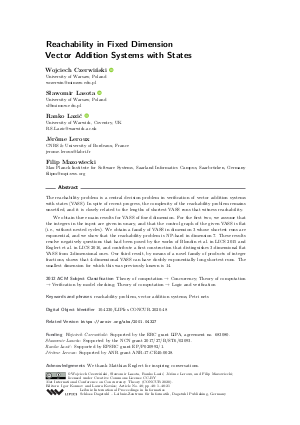@InProceedings{czerwinski_et_al:LIPIcs.CONCUR.2020.48,
author = {Czerwi\'{n}ski, Wojciech and Lasota, S{\l}awomir and Lazi\'{c}, Ranko and Leroux, J\'{e}r\^{o}me and Mazowiecki, Filip},
title = {{Reachability in Fixed Dimension Vector Addition Systems with States}},
booktitle = {31st International Conference on Concurrency Theory (CONCUR 2020)},
pages = {48:1--48:21},
series = {Leibniz International Proceedings in Informatics (LIPIcs)},
ISBN = {978-3-95977-160-3},
ISSN = {1868-8969},
year = {2020},
volume = {171},
editor = {Konnov, Igor and Kov\'{a}cs, Laura},
publisher = {Schloss Dagstuhl -- Leibniz-Zentrum f{\"u}r Informatik},
address = {Dagstuhl, Germany},
URL = {https://drops-dev.dagstuhl.de/entities/document/10.4230/LIPIcs.CONCUR.2020.48},
URN = {urn:nbn:de:0030-drops-128605},
doi = {10.4230/LIPIcs.CONCUR.2020.48},
annote = {Keywords: reachability problem, vector addition systems, Petri nets}
}

 Creative Commons Attribution 3.0 Unported license
Creative Commons Attribution 3.0 Unported license
